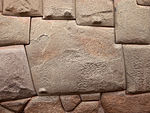

Qargi (Inupiaq: [qɑɻɣi]), Qasgi or Qasgiq (by the Yup'iks), Qaygiq (by the Cup'iks), Kashim (by the Russians), Kariyit, a traditional large semi-subterranean men's community house' (or "communal men's house, men's house, ceremonial house, council house, dance house, communal gathering place") of the Yup'ik and Inuit, also Deg Hit'an Athabaskans (at Anvik, Alaska), was used for public and ceremonial occasions and as a men's residence. The Qargi was the place where men built their boats, repaired their equipment, took sweat baths, educated young boys, and hosted community dances. Here people learned their oral history, songs and chants. Young boys and men learned to make tools and weapons while they listened to the traditions of their forefathers.
The qargi was almost always a separate building because the dwellings were not large enough to hold very many men. The qargi was a combination courthouse, church, workshop, dance hall, and received center, two or three times the size of a typical house. It was the place where the storytelling, dancing, singing, and games (high-kick games) that so enriched Yupik and Inuit life took place. The qargi was a communal building in which women were usually not permitted.
Prior to the arrival of Christian missionaries in the 1890s, every Inupiaq settlement had one or more of these ceremonial houses.
Naming
| Language | singular | dual | plural |
|---|---|---|---|
| Naukan Yupik | Qaygi | ||
| Central Alaskan Yup'ik | Qasgi / Qasgiq | Qasgit | |
| Chevak Cup’ik | Qaygiq | Qaygit | |
| Nunivak Cup'ig | Kiiyar | ||
| Inupiaq (Alaskan Inuit) | Qargi | Qargik | Qargich / Qargit |
| Inupiaq (Little Diomede) | Qaġsriq | Qaġsrik | Qaġsrit |
| Inupiaq (King Island) | Qagzriq | Qagzrik | Qagzrit |
| Inuvialuk (Western Canadian Inuit) | Qadjgiq | ||
| Inuktitut (Eastern Canadian Inuit) | Qaggiq ᖃᒡᒋᖅ | ||
| Kalaallisut (West Greenland Inuit) | Qassi |
School
In many Iñupiat communities the qargi was the first institution to vanish as churches and schools became the dominant forces of change. At present, Iñupiat elders have no responsibility for the formal education of young Iñupiat.
Before 1950, formal education for students in Chevak, Alaska took place in the qaygiq, and in the homes of the people. The information taught to students in the qaygiq included history, values, rules, regulations, and survival methods.
See also
References
- James M. Savelle (2002), The Umialiit-Kariyit Whaling Complex and Prehistoric Thule Eskimo Social Relations in the Eastern Canadian Arctic Archived March 2, 2014, at the Wayback Machine, Bulletin of National Museum of Ethnology 27(1): 159–188 (2002)
- Fair, Susan W. (2006). Alaska Native Art: Tradition, Innovation, Continuity. University of Alaska Press. p. 160. ISBN 978-1-889963-79-2.
- Edna Ahgeak MacLean, Culture and Change for Iñupiat and Yupiks of Alaska
- Burch, Ernest S. (2006). Social Life in Northwest Alaska: The Structure of Iñupiaq Eskimo Nations. University of Alaska Press. p. 110. ISBN 978-1-889963-92-1.
- ^ John Taliaferro (2007). In a Far Country. PublicAffairs. p. 35. ISBN 978-0-7867-4123-6.
- Arctic Studies
- Burch, Ernest S. (2005). Alliance and Conflict: The World System of the In?piaq Eskimos. U of Nebraska Press. p. 92. ISBN 0-8032-6238-8.
- St Lawrence Island Native American history Navajo rugs Archived August 5, 2012, at the Wayback Machine
- Qasgimi : In the Qasgi
- Nuniwarmiut Piciryarata Tamaryalkuti, Nunivak Island Cup'ig Language Preliminary Dictionary Archived August 5, 2012, at the Wayback Machine
- Carol Zane Jolles (2006), Iñupiaq Maritime Hunters: Summer SubsistenceWork in Diomede, in Circumpolar Lives and Livelihood, A Comparative Ethnoarchaeology of Gender and Subsistence, edited by Robert Jarvenpa and Hetty Jo Brombach, University of Nebraska Press, Lincoln and London, 2006
- Future King Island Speakers
- MacLean, Edna Ahgeak (1986). The Revitalization of the Qargi, the Traditional Community House, as an Educational Unit of the Inupiat Community
- Pingayak, John; Qaygiq (Men’s House)
- Alaskool: Guidebook for Integrating Cup'ik Culture and Curriculum
External links
| Hut dwelling designs and semi-permanent human shelters | ||
|---|---|---|
| Traditional immobile |
|  |
| Traditional mobile | ||
| Open-air | ||
| Modern | ||
| Related topics | ||
| Native American architecture | ||
|---|---|---|
| Styles |  | |
| Building types | ||
| Structures | ||
| Elements | ||
| Architecture of the United States | |
|---|---|
| Native and indigenous | |
| Colonial and post-colonial | |
| Early Republic | |
| Mid-19th century | |
| Victorian | |
| Late-19th to mid-20th century |
|
| Post–World War II | |
| Building types and vernacular |
|
| Cities | |
| States | |